Civic engagement platforms play a crucial role in enhancing communication between citizens and local governments, thereby facilitating participation in decision-making processes. By addressing community needs through various features and accessibility options, these platforms ensure that diverse voices are heard and considered. A thorough comparison of these tools can reveal their effectiveness in promoting active civic participation and meeting specific community goals.
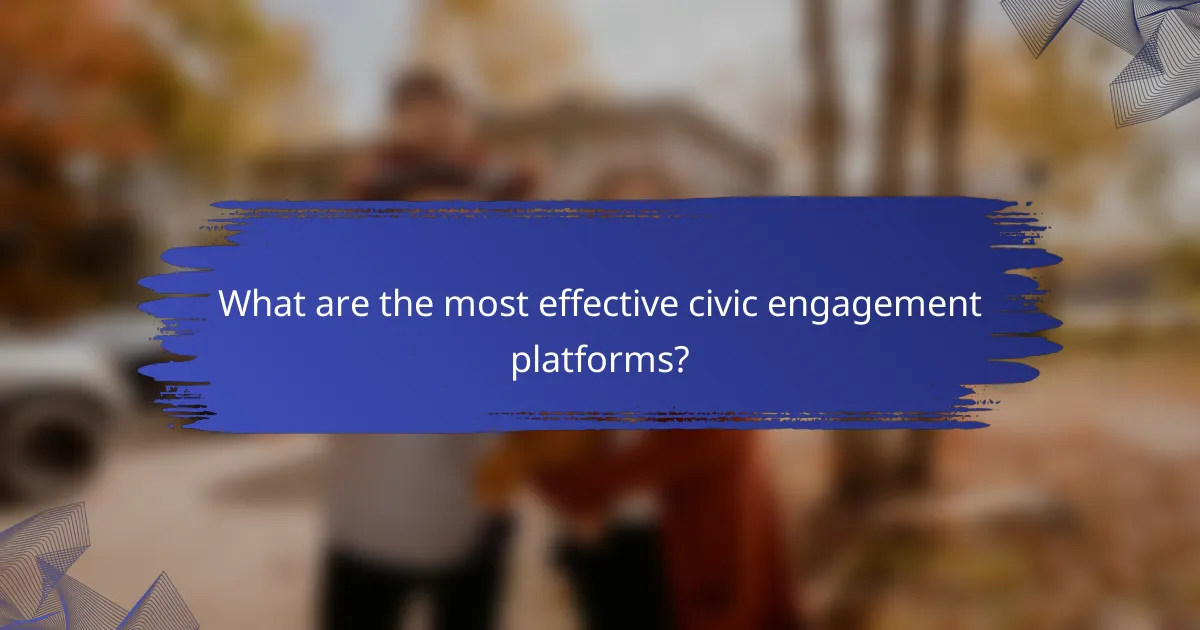
What are the most effective civic engagement platforms?
The most effective civic engagement platforms facilitate communication between citizens and local governments, enabling participation in decision-making processes. These platforms vary in features, target audiences, and effectiveness based on community needs and engagement goals.
Nextdoor
Nextdoor is a social networking service designed for neighborhoods, allowing residents to connect and share information relevant to their local area. It is particularly effective for fostering community engagement through discussions about local issues, events, and safety concerns.
When using Nextdoor, consider its focus on hyper-local interactions. Users can create posts, ask for recommendations, or report issues, which can help local governments gauge community sentiment. However, be mindful of privacy concerns, as the platform requires real names and addresses.
CitizenLab
CitizenLab is a digital platform that enables local governments to engage citizens in policymaking through surveys, discussions, and idea submissions. It is particularly useful for gathering feedback on specific projects or initiatives.
This platform allows for structured engagement, where citizens can vote on ideas and contribute to shaping local policies. A key advantage is its ability to analyze data and provide insights into community preferences, but it may require a commitment from local officials to respond to citizen input effectively.
Bang the Table
Bang the Table focuses on online community engagement, providing tools for dialogue and collaboration between citizens and government. It supports various engagement methods, including surveys, forums, and interactive maps.
One of its strengths is the ability to customize engagement strategies based on specific community needs. However, successful implementation requires ongoing promotion and support from local authorities to ensure high participation rates.
Polis
Polis is a platform designed to facilitate large-scale discussions and gather diverse opinions on community issues. It uses a unique method of dialogue that allows participants to express their views and see how they align with others.
This platform is particularly effective for understanding complex community sentiments and fostering consensus. However, it may require trained facilitators to guide discussions and interpret results effectively, which can be a resource-intensive process.
Change.org
Change.org is a popular petition platform that empowers individuals to advocate for social change by gathering signatures for various causes. It is effective for raising awareness and mobilizing support for specific issues.
While Change.org can amplify voices and drive action, it often requires a strategic approach to gain traction. Successful campaigns typically include clear messaging and a well-defined target audience. However, the platform may not always lead to direct engagement with local governments, as it primarily serves as a petitioning tool.
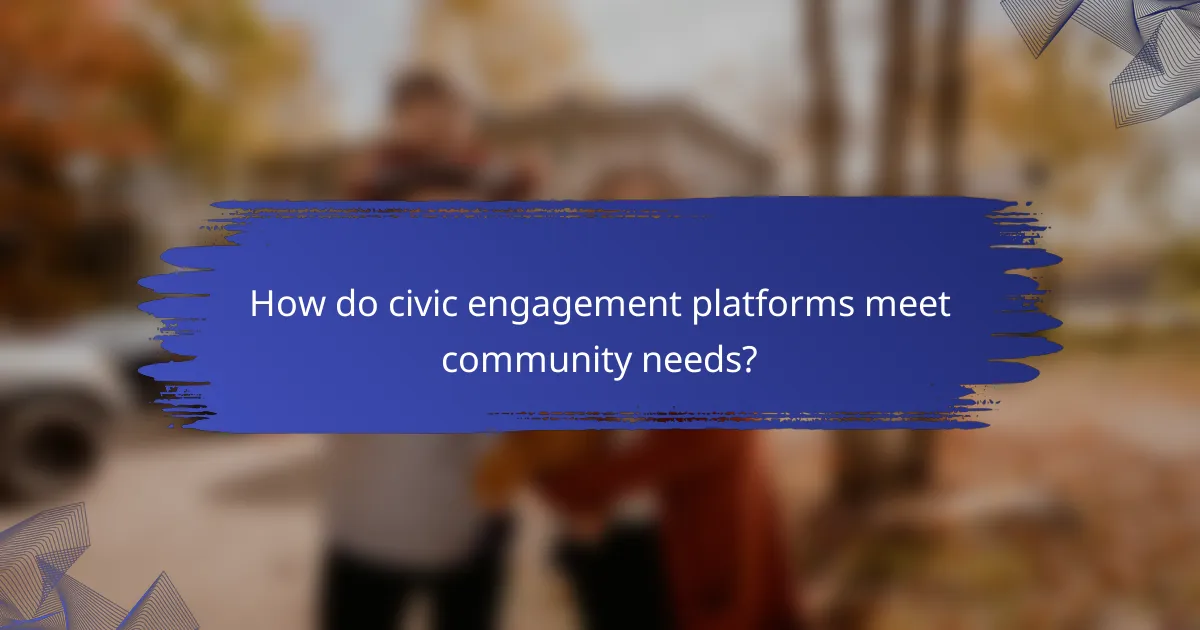
How do civic engagement platforms meet community needs?
Civic engagement platforms address community needs by fostering communication, encouraging participation, and providing avenues for feedback. These tools help bridge gaps between local governments and citizens, ensuring that community voices are heard and considered in decision-making processes.
Facilitating local discussions
Civic engagement platforms create spaces for local discussions by allowing community members to share ideas, concerns, and solutions. Features like forums, chat rooms, and event calendars enable residents to connect and engage on various topics relevant to their community.
For effective discussions, platforms should prioritize user-friendly interfaces and moderation to maintain a respectful environment. Encouraging participation through incentives, such as recognition or small rewards, can also enhance engagement.
Enhancing voter participation
Civic engagement platforms play a crucial role in enhancing voter participation by providing information on upcoming elections, candidates, and voting procedures. They often include features like registration reminders and personalized voting guides to help users navigate the electoral process.
To maximize impact, platforms should target outreach efforts to underrepresented groups, ensuring that information is accessible in multiple languages and formats. Collaborating with local organizations can further amplify these efforts and drive higher turnout rates.
Providing feedback channels
Feedback channels on civic engagement platforms allow community members to voice their opinions and concerns directly to local officials. These channels can take the form of surveys, polls, or suggestion boxes, enabling residents to contribute to policy discussions and community planning.
For effective feedback mechanisms, platforms should ensure anonymity and ease of use, encouraging honest responses. Regularly updating the community on how feedback is being utilized can also foster trust and encourage ongoing participation.
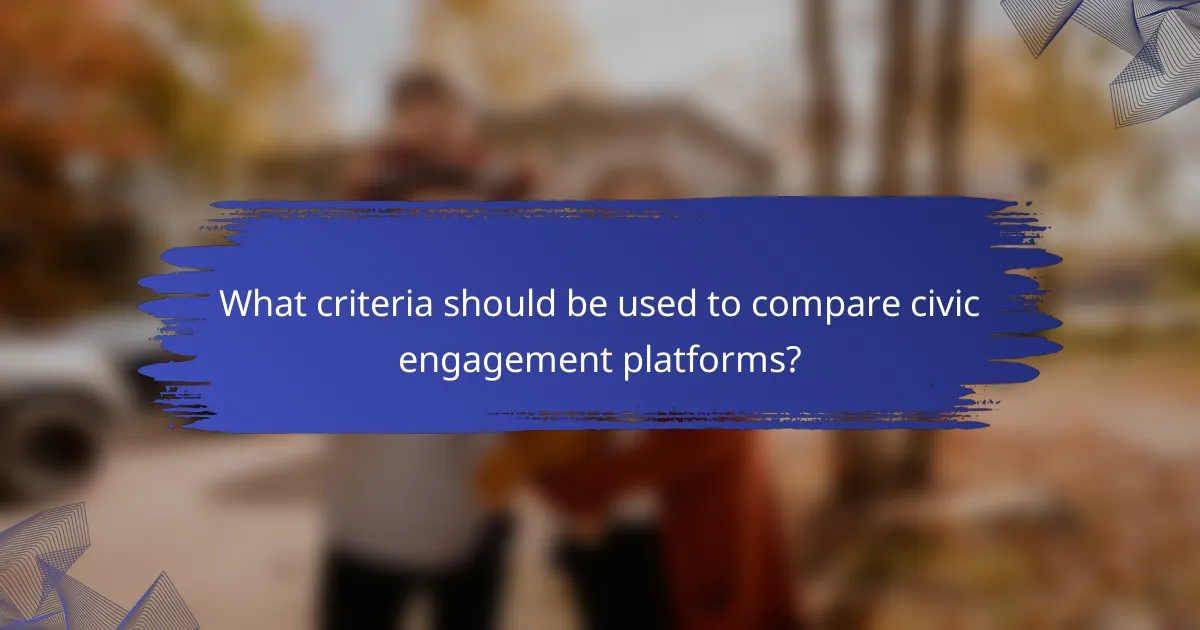
What criteria should be used to compare civic engagement platforms?
To effectively compare civic engagement platforms, consider user engagement metrics, accessibility features, and integration with local government. These criteria help determine how well a platform meets community needs and facilitates active participation.
User engagement metrics
User engagement metrics are essential for assessing how effectively a platform fosters participation. Key indicators include the number of active users, frequency of interactions, and the duration of user sessions. Platforms that show high engagement rates often have features that encourage ongoing dialogue and feedback.
Look for metrics such as user retention rates and the number of posts or comments generated. A platform that promotes community discussions and allows users to share their opinions can significantly enhance civic involvement.
Accessibility features
Accessibility features ensure that civic engagement platforms are usable by all community members, including those with disabilities. Important aspects include screen reader compatibility, keyboard navigation, and text-to-speech options. Platforms that prioritize accessibility can reach a broader audience and ensure inclusivity.
Consider whether the platform adheres to established accessibility standards, such as the Web Content Accessibility Guidelines (WCAG). Features like adjustable text sizes and color contrast options can also improve usability for individuals with visual impairments.
Integration with local government
Integration with local government systems is crucial for civic engagement platforms to facilitate effective communication between citizens and officials. A platform that allows for seamless data sharing and collaboration can enhance transparency and responsiveness. Look for features that enable users to submit feedback directly to government representatives.
Platforms that offer real-time updates on community projects or local policies can keep citizens informed and engaged. Additionally, check if the platform supports local regulations and compliance requirements, which can impact its effectiveness in different regions.
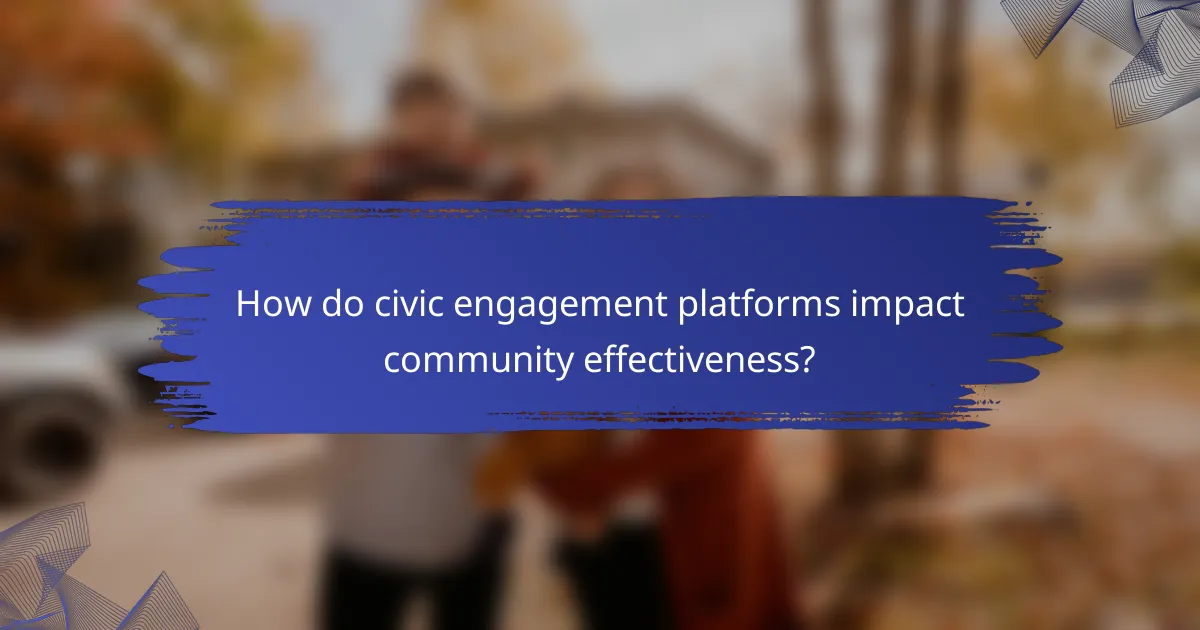
How do civic engagement platforms impact community effectiveness?
Civic engagement platforms significantly enhance community effectiveness by facilitating communication between citizens and local governments. These tools enable residents to participate in decision-making processes, fostering a sense of ownership and accountability within the community.
Increased community participation
Civic engagement platforms drive increased community participation by providing accessible channels for residents to voice their opinions and concerns. Features such as surveys, polls, and discussion forums allow individuals to engage actively, leading to higher turnout in local events and initiatives.
For example, a platform may host a virtual town hall meeting, allowing hundreds of residents to join from their homes. This accessibility can lead to participation rates that are significantly higher than traditional in-person meetings, especially in diverse communities with varying mobility and scheduling challenges.
Improved transparency in governance
These platforms enhance transparency in governance by making information readily available to the public. Residents can access data on local government activities, budgets, and decision-making processes, which helps build trust between citizens and officials.
For instance, a civic engagement platform may publish real-time updates on city council meetings and decisions, allowing residents to stay informed and hold their leaders accountable. This transparency can lead to more informed community members who are better equipped to engage in civic discussions and advocate for their needs.

What are the challenges faced by civic engagement platforms?
Civic engagement platforms encounter several challenges that can hinder their effectiveness. Key issues include the digital divide, which limits access for some communities, and data privacy concerns, which can deter users from participating.
Digital divide issues
The digital divide refers to the gap between individuals who have easy access to digital technology and those who do not. This disparity can significantly impact civic engagement, as marginalized communities may lack reliable internet access or necessary devices, limiting their ability to participate in online platforms.
To address digital divide issues, civic engagement platforms should consider offering offline alternatives or mobile-friendly solutions that require less bandwidth. Collaborating with local organizations to provide resources like community internet access points can also help bridge this gap.
Data privacy concerns
Data privacy concerns are critical for users of civic engagement platforms, as individuals may worry about how their information is collected, stored, and used. Platforms must ensure compliance with regulations like the General Data Protection Regulation (GDPR) in Europe, which mandates strict data handling practices.
To build trust, civic engagement platforms should be transparent about their data policies and provide users with clear options for privacy settings. Regular audits and updates to security measures can also help alleviate concerns and encourage broader participation.
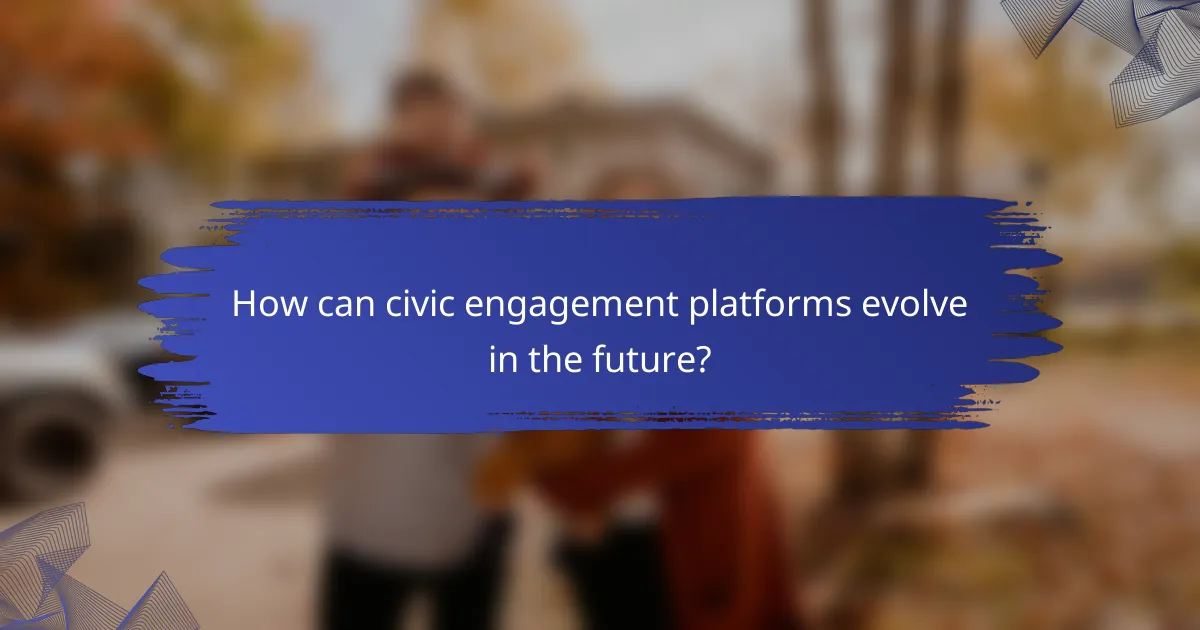
How can civic engagement platforms evolve in the future?
Civic engagement platforms can evolve by integrating advanced technologies and enhancing accessibility to better meet community needs. Future developments should focus on personalization, mobile access, and user-friendly interfaces to foster greater participation in civic activities.
Incorporating AI for personalized engagement
AI can significantly enhance civic engagement platforms by tailoring experiences to individual users. By analyzing user behavior and preferences, platforms can deliver customized content, notifications, and recommendations that resonate with specific community interests.
For instance, an AI-driven platform might suggest local events, volunteer opportunities, or policy discussions based on a user’s previous interactions. This level of personalization can increase user satisfaction and participation rates.
However, platforms must ensure transparency in how AI algorithms operate and protect user data privacy. Clear communication about data usage can build trust and encourage more users to engage with the platform.
Expanding mobile accessibility
Mobile accessibility is crucial for civic engagement platforms to reach a broader audience. As smartphones become ubiquitous, ensuring that platforms are optimized for mobile use can facilitate easier access to civic resources and participation opportunities.
Platforms should focus on creating responsive designs that work seamlessly on various devices and screen sizes. Features like push notifications can keep users informed about local events and initiatives, encouraging timely engagement.
Additionally, incorporating offline capabilities can help users in areas with limited internet access. Simple functionalities, such as downloadable resources or SMS alerts, can bridge the gap and ensure that all community members can participate actively.










